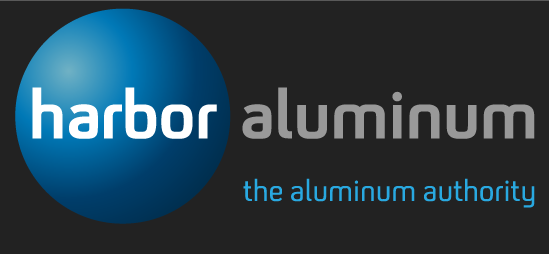Aluminum Production & Manufacturing Process Explained
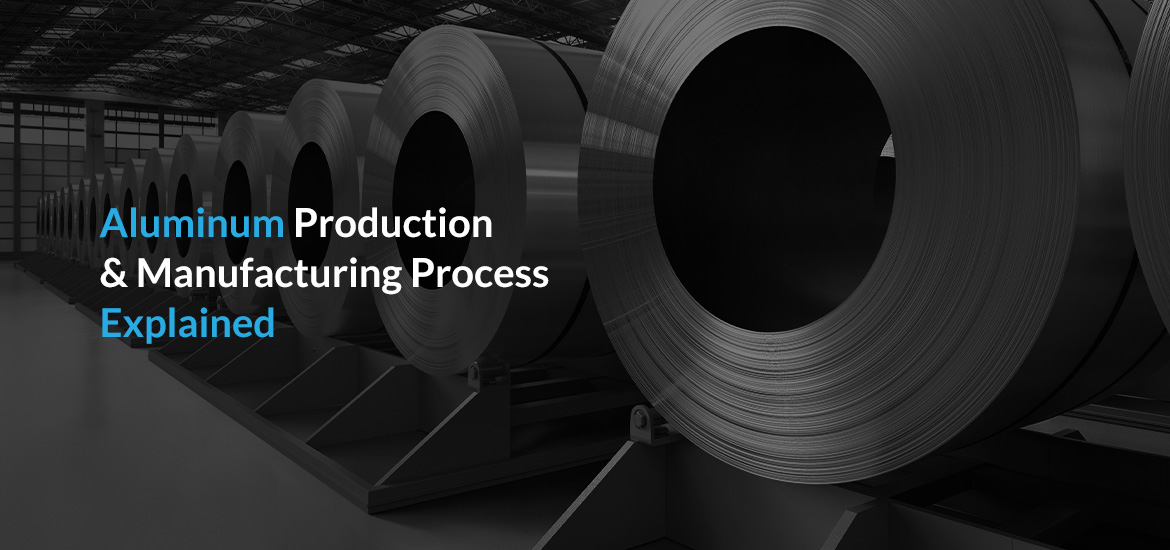
Aluminum is found in a vast range of products, from soda cans to car components. Yet, not many people know what aluminum is made of or how it's made. Although aluminum is found abundantly in the earth's crust in the mineral cryolite and the rock bauxite, you won't find it in pure form in everyday products.
Aluminum is made of other elements because it does not naturally occur in pure form. It needs to undergo chemical processes before it can be turned into standard products like foil and food packaging.
The History of Aluminum Production and Manufacturing
Aluminum production has a long history, dating back to ancient times when an aluminum-based salt called Alum was used for its fire-resistant properties in the leather and paper industries. However, it was not until the 19th century that aluminum, as we know it today, was discovered.
In 1808, English chemist Humphry Davy theorized that aluminum could be produced by electrolytically reducing alumina or aluminum oxide, but lacked the necessary equipment to test his idea. It wasn't until 1825 when Hans Christian Oersted created an aluminum alloy based on Davy's ideas.
German chemist Friedrich Woehler furthered Oersted's work and produced the first small mounds of solidified molten aluminum in 1845. Henri-Etienne Sainte-Claire Deville then utilized chemical methods to create industrial aluminum and produced it in France in 1856. Initially, it was an expensive luxury metal, similar to silver and used for making medals.
Under Napoleon III's leadership, aluminum production in France received significant backing, leading to an exciting future for the metal. Today, aluminum is widely used in various industries due to its unique properties, including its lightweight and corrosion resistance.
Two individuals, Paul Heroult and Charles Hall, redefined the aluminum creation process in 1886. The engineer and student recognized the reduction of molten aluminum oxide in cryolite was effective for making aluminum using electric power. The Hall-Heroult process is a primary way of making aluminum in the 21st century.
Another method for producing aluminum was discovered by Karl Josef Bayer in 1888. The Bayer process involves heating bauxite and an alkali mixture to create aluminum.
Steps in Aluminum Production and Manufacturing
In general, the aluminum-making process involves three steps: mining for bauxite, extracting alumina from the mined bauxite and turning the alumina into aluminum. In this guide, we'll look at each step of the aluminum production process from the mine to the shelves to show you how it's made.
Step 1: The Bauxite Mining Process
Aluminum is not found in its pure form in nature and needs to be extracted from bauxite. Bauxite is a type of sedimentary rock featuring traces of aluminum. This rock is the world's main source of aluminum, and experts must refine the sedimentary rock to create alumina. Most countries have bauxite deep below the earth's surface, but the material is more abundant in tropical zones. Aside from Africa and South America, China, India and Indonesia are top providers of bauxite rock. Bauxite is primarily used in the aluminum-making industry, but there is a place for the sedimentary rock in the adhesive, cement and chemical fields as well.
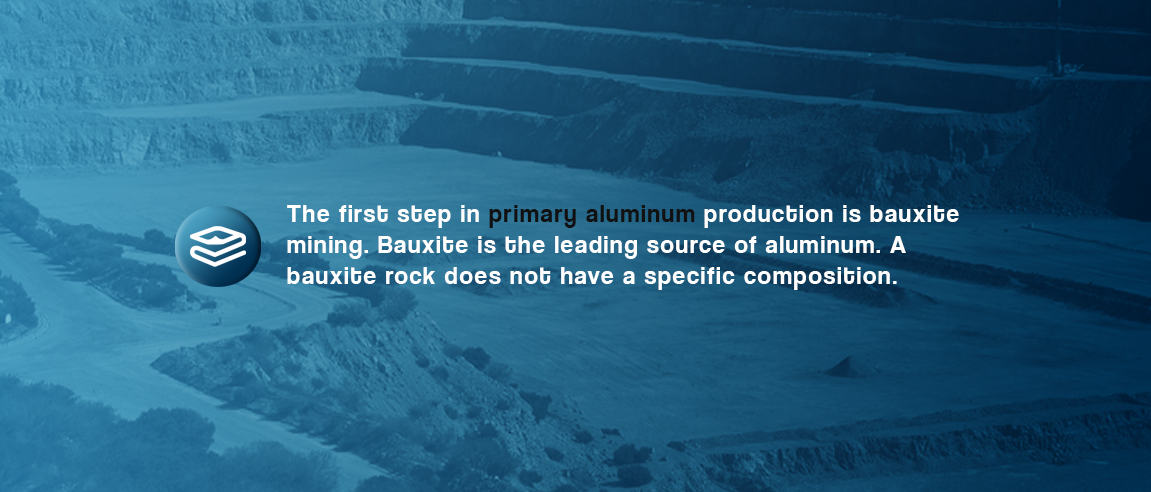
Mining for Aluminum Bauxite
The process of mining aluminum involves extracting bauxite ore, refining it to produce alumina, and then smelting the alumina to extract pure aluminum. The extracted aluminum can then be used to manufacture a wide range of products, from aircraft parts to cans.
Bauxite rock is mined and extracted through land clearing, digging, and removing thick sections of bauxite ore by means of blasting or ripping. Bauxite mining calls for the use of heavy equipment. Miners commonly use machines like bulldozers, scrapers, front-end loaders, and hydraulic excavators to help with the digging. Areas rich with bauxite can be restored once the aluminum mining process is complete.
Clear the Land and Remove the Topsoil
Bauxite is typically found near the surface and extracted from the earth via open-pit mining or strip mining techniques. Both of these mining methods involve removing the soil and rocks covering the layer of bauxite.
Mining starts with the removal of trees and vegetation. The topsoil is then removed and stored for the post-mining restoration process. In most forested areas where bauxite mining takes place, the land returns to its original ecosystem. This is made possible through mine rehabilitation practices that include leveling the land and replacing the topsoil that was displaced.
Miners must make sure the aluminum production cycle does not interfere with animal and plant life in mining locations. Therefore, red mud is removed from mining areas to prevent harmful pollution to the environment.
Break, Load, and Transport
Once miners reach the layer of bauxite, they might use drilling or blasting methods to break the bauxite into loose pieces. The bauxite pieces are then usually loaded into a truck or other vehicle and transported to a plant for crushing and sorting.
Bauxite aluminum can be transported in shipping containers by truck, rail, or ship. Below is a breakdown of each of the common methods of bauxite transportation.
- Truck: Aluminum can be transported in trucks or trailers designed for transporting heavy goods. This is a common method for short-distance transportation of aluminum within a region or country.
- Rail: Rail transportation is a cost-effective and environmentally friendly option for long-distance transportation of aluminum. Rail transport is often used to transport aluminum within a country or between neighboring countries.
- Ship: For larger quantities of aluminum, specialized bulk carriers may be used. These vessels are designed to carry dry bulk cargo, including aluminum, and have large hatches that can be opened to load and unload the cargo.
Some forms of bauxite require miners to clean and dry the materials before shipping them to refineries. In these scenarios, clay is removed from the bauxite and the materials are placed into kilns. Most alumina refineries are located near the mines to streamline transportation.
Although bauxite has various applications, about 85 percent of bauxite production is used to manufacture alumina. As the demand for quality aluminum products continues to grow, so will the need for bauxite mining. It's estimated that the current bauxite reserves will last for centuries.
Related: Top 10 Aluminum Producing Countries
Step 2: Turning Bauxite into Alumina through the Bayer Process
The second step in aluminum production is alumina refining. To separate alumina from bauxite, the sedimentary rock is exposed to caustic soda at extreme temperatures. Alumina can be removed from bauxite, but the process requires the use of precipitator tanks in a refining facility.
What Is Alumina?
Alumina is the name given to aluminum oxide, which is a white, odorless powder. Alumina is used in many different industries. For example, it's applied in metallic paint manufacturing as well as the production of spark plug insulations.
Professionals use alumina as a starting material for producing aluminum metal. Alumina exists as a chemical compound of aluminum and oxygen, and it has a close physical resemblance to table salt. The compound features a boiling point of 2980 degrees Celsius and a melting point of 2040 degrees Celsius.
How Is Alumina Refined?
Alumina refining involves extracting alumina from bauxite using a method called the Bayer process. Most of the world's refineries still use the Bayer process, which was invented in 1887, to produce alumina. From every two pounds of alumina, you can create one pound of aluminum.
The Bayer process involves dissolving bauxite with caustic soda. Filtering is necessary to remove impurities. Professionals move the alumina mixture to precipitators for cooling, and aluminum hydroxide seeds are combined to encourage the creation of aluminum hydroxide crystals. Once the aluminum hydroxide solidifies and settles at the base of the tank, it can be taken out. Aluminum hydroxide must be washed and heated to remove water.
At the end of the refining process, alumina is present as a delicate white powder.
The Bayer Process Explained
The Bayer process was invented by the Austrian chemist Karl Josef Bayer. When chemists discovered they could combine the Bayer process with the Hall-Heroult electrolytic process, both methods gained popularity in the world of aluminum production. The Bayer process consists of the following steps:
- The bauxite is crushed, washed, and dried.
- Next, a heated sodium hydroxide solution is used to dissolve the bauxite.
- The mixture undergoes a filtration process to remove impurities known as "red mud."
- The solution containing oxides of aluminum is transferred to a tank called a precipitator.
- In the precipitator tank, the solution cools, and small aluminum hydroxide particles are added to stimulate the growth of solid aluminum hydroxide crystals.
- The aluminum hydroxide crystals settle at the bottom of the precipitator tank and are removed.
- The aluminum hydroxide is then washed to clean off residue and then heated to remove excess water.
The Bayer process results in alumina, which looks similar to sugar in appearance.
Step 3: Alumina to Aluminum with the Hall-Heroult Process
Once alumina is formed, it needs to undergo a smelting process, called the Hall-Heroult process, to produce pure aluminum. The smelting process involves extracting aluminum by methods of heating and melting.
Charles Hall and Paul Heroult simultaneously and independently invented the Hall-Heroult process in 1886. The process is still used today to make aluminum.
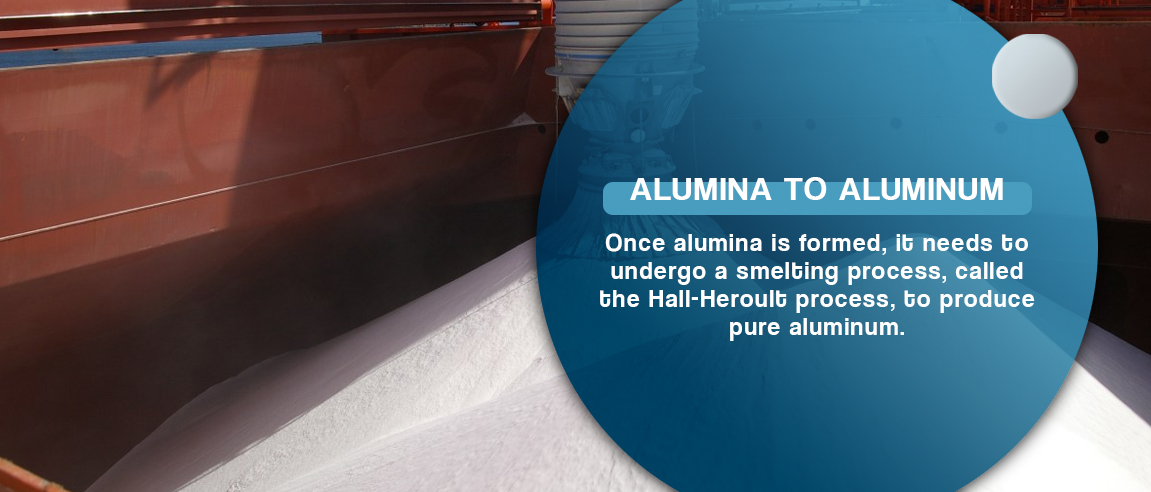
The Hall-Heroult process is used to produce most commercial aluminum. It consists of the following steps:
- In a carbon-lined pot, alumina is dissolved in a bath of molten cryolite.
- Carbon anodes, which are used to conduct electricity, are placed in the pots.
- An electric current passes through the anodes and the alumina-cryolite mixture.
- The electricity keeps the mixture extremely hot and allows the alumina to separate into aluminum and oxygen.
- The molten aluminum is siphoned from the pots and transferred to a casthouse to be formed into blocks, called ingots, slabs, or other shapes.
Related: The Aluminum Smelting Process Explained
Step 4: Aluminum is Fabricated into Finished Products
After aluminum is molded, it's distributed to manufacturers who then turn it into consumer products. A manufacturer will create new aluminum products by remelting them and adding alloys or other materials they need. Pure aluminum does not feature great tensile strength. For this reason, it's often alloyed with small amounts of different materials, such as copper, iron, or titanium, to make it stronger or give it other properties. Manufacturers will then recast the mixture into the desired shape.
Common Aluminum Fabrication Methods
Many manufacturers order large aluminum slabs. They roll the slabs into thin sheets for use in foil, can and car panel manufacturing. Aluminum makes an excellent material for producing beverage and food cans, for example. This is because aluminum cans are infinitely recyclable, lightweight, easy to chill, smooth enough for printing labels and good at preserving the product inside.
The term aluminum fabrication describes the process of manufacturing aluminum into a new shape or product. Some of the most common fabrication techniques are outlined below.
Aluminum Extrusions
Extrusion techniques involve guiding a piece of aluminum through or around a die to reshape the metal. Depending on the product you are manufacturing, it is possible to complete aluminum extrusion methods where aluminum is heated or at room temperature.
Aluminum Casting
Professionals rely on aluminum castings to create products out of molds. With casting methods, aluminum is heated until it changes to liquid form. The liquid metal is then poured into a die or mold where it cools and hardens to take the shape and size of the molding piece.
Aluminum castings are usually created using 4xxx and 5xxx alloys because of their excellent wear resistance.
Aluminum Forging
The forging process requires fabricators to compress aluminum into the desired shape through hammering or beating aluminum sheets. Aluminum forging is necessary when components or products must be exceptionally durable. For example, vehicle parts may be subject to forging techniques to enhance the materials stress-handling capabilities.
Aluminum Forming and Rolling
Aluminum is flexible and soft. Select alloys like aluminum 3003, which contains manganese, can be rolled into sheets or plates. Fabricators can create large aluminum sections to assemble vehicles, planes, rail cars and other technology.
Aluminum Drawing
Decision-makers in the electrical and construction industries rely on aluminum drawing fabrication methods to pull the metal through dies. Aluminum drawing enables workers to stretch the metal into wiring or cans for storing liquids like paint.
Aluminum Machining
Some fabrication jobs require cutting into metal sheets. Machining describes the process of changing the shape and size of a metal product by removing sections.
Aluminum changes form when exposed to heat, so it is crucial to use specialized equipment, tools and lubricants for sculpting aluminum parts and products.
Waterjet Cutting
Rather than using heat, fabricators can spray high-pressure water across aluminum surfaces. Waterjet cutting operations allow the alteration of the shape of the metal without changing its original properties as heat would.
Aluminum Welding
Metal fabricators can merge two pieces of aluminum together through metal inert gas (MIG) or tungsten inert gas (TIG) welding procedures. It's possible to attach metal surfaces together by heating an aluminum thread.
Related: Aluminum Rolling Mills Explained
Industries that Rely on Aluminum
Although aluminum is used in manufacturing a wide array of products, the global aluminum market consists of several industries.
- Packaging: Aluminum has been used as a form of food and beverage packaging since the early 1900s. You'll find aluminum foil encasing everything from candy to frozen dinners. The demand for aluminum packaging continues to grow to meet the rise of processed food consumption in developing countries.
- Automotive: As car manufacturers look to replace steel with aluminum, which is much more lightweight and can increase fuel efficiency, it's fulfilling a vital role in the auto industry.
- Construction: Aluminum is used in construction as an energy-efficient and sustainable building material. China has the highest demand for aluminum as a construction material. In America, you'll commonly find aluminum used in windows and doors.
- Aerospace: Aluminum has been used in the development of aerospace technology since the Wright brothers used metal in building the engine for their first biplane. Since then, it's been used to construct both aircraft and spacecraft. Aluminum alloys are valued for their lightness and mechanical stability, which makes them ideal materials for flying vehicles. NASA's spacecraft, the Orion, is constructed with an aluminum-lithium alloy.
- Electrical: Aluminum has been used in electrical wiring since the start of the 20th century. After World War II, aluminum wiring quickly grew in popularity and started to replace copper. It's now the preferred choice for conducting electricity.
- Appliances: Aluminum can be found in household items ranging from washing machines to smartphones and makes it possible to enjoy many modern amenities. For example, aluminum is used to make a lightweight TV casing, so that consumers can mount their TVs on the wall.
Aluminum is the most widely used and distributed metal in the world. It's also been around for much longer than you might think. For example, an ornament composed of 85 percent aluminum was discovered in the tomb of a third-century Chinese military leader. No one knows how the ornament was produced.
Now, just about every person in the United States uses aluminum every day, whether they realize it or not. It's favored for its malleability, low melting point, and resistance to corrosion.
Step 5: Aluminum Recycling
Since aluminum is 100 percent recyclable, the manufacturing process doesn't end once it reaches the consumer. Many recyclable aluminum products undergo a secondary production process. Secondary production is the process of turning scrap into aluminum that can be used again in the manufacturing of another product.
HARBOR estimates that 53 percent of the aluminum supply in North America comes from secondary production. Over 90 percent of aluminum used in the automotive and construction industries is recycled.
Aluminum cans, in particular, are the most recycled beverage containers in the U.S., and in 2018, over 56 billion cans were recycled. If everyone recycled every aluminum can they used, it could save enough energy to power over four million homes for an entire year.
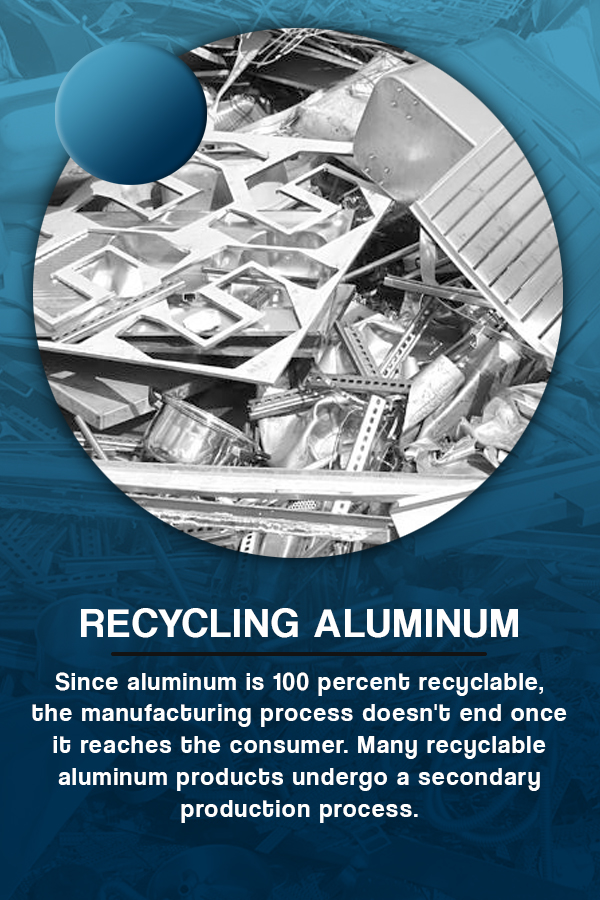
How Aluminum is Recycled
Here's an overview of how the aluminum recycling process works:
- A consumer tosses aluminum products, such as beverage cans, in a recycling bin.
- A recycling company collects aluminum products and transports them to a treatment facility.
- The scrap aluminum is sorted and cleaned.
- The scrap metal is loaded into a furnace and turned into molten aluminum, which removes any coatings and inks.
- The melted aluminum is poured into molds and cooled to form ingots, which can then be used to manufacture any aluminum-containing product.
- The ingots may be rolled into a sheet or another shape.
It doesn't take long for recycled aluminum to get back on the shelf again. For example, an aluminum beverage container can be recycled and back on the shelf in about 60 days. Aluminum can be reused over and over again without losing quality.
Related: Aluminum Reycling in the Scrap & Secondary Market
Understanding the Aluminum Market
Aluminum is a commodity. Commodities are basic goods that can be bought or sold. They are also interchangeable with other materials of the same type. For example, commodities like oil and gold generally feature the same characteristics, no matter who produces them. Commodities are usually raw materials or agricultural products that are used to produce other goods.
They fall under two different categories: hard commodities such as aluminum, gold, and oil, and soft commodities such as agricultural products, which include corn, wheat, and sugar. Anyone who regularly works closely with aluminum may choose to keep an eye on the commodity market.
Aluminum Futures and Exchanges
Investors and traders can buy commodities directly, or they might purchase futures or options contracts. With a futures contract, the person is obligated to buy or sell a commodity at a predetermined price on a future date. Futures allow traders to profit from short-term price fluctuations. With an options contract, the investor is not required to buy or sell shares at a specific date. Here are some common considerations regarding aluminum commodity trading:
- Commodities are usually sold and purchased through futures contracts on exchanges. Exchange refers to the marketplace where commodities are traded. The London Metal Exchange (LME) is the main international exchange for trading metals.
- Commodities are incredibly volatile and require monitoring every day. The global supply can change quickly and be affected by various factors. Even someone who doesn't invest in or trade commodities might want to watch the market. For example, a manufacturer of aluminum products might follow the price of aluminum carefully, because it will affect their operating costs.
- Commodity prices are unpredictable, but as a general rule, they're affected by supply and demand. Usually, greater demand and lower supply lead to higher prices, and an oversupply leads to lower prices. With that in mind, many factors impact aluminum prices, such as the demand for metal in auto and aerospace manufacturing, and construction growth rates.
Changes in oil prices, electricity costs, and exchange rates also affect aluminum prices because they impact the production process. Considering the various elements that determine market prices, it's difficult to predict what will happen next.
Related: Aluminum Trading and Pricing Explained
Contact HARBOR for Aluminum Prices & Market Forecasting
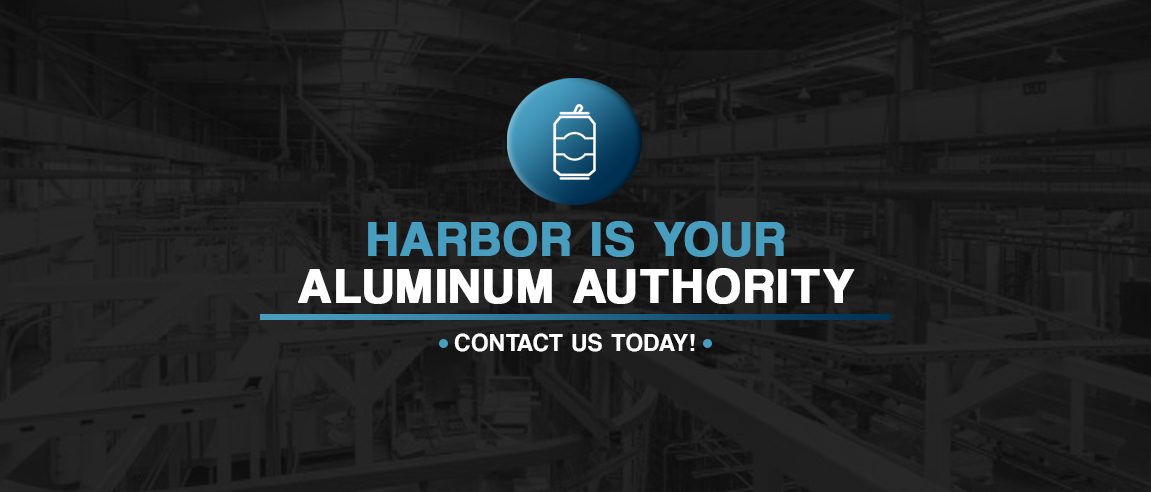
At HARBOR Aluminum Intelligence, we help purchasing managers, marketing and sales executives, investors, and industry analysts better navigate the aluminum market. We deliver to our clients, detailed price reports, market intelligence, and expert insight for all relevant aluminum products (including scrap items).
If you need aluminum market intelligence and insight from a firm with decades of industry experience, contact HARBOR Aluminum, or subscribe to our market intelligence reports today.
